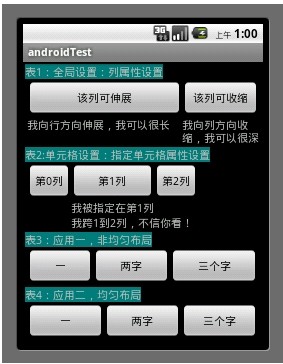android 统一布局属性,android:TableLayout表格布局详解 |
您所在的位置:网站首页 › tablelayout表格布局详解 › android 统一布局属性,android:TableLayout表格布局详解 |
android 统一布局属性,android:TableLayout表格布局详解
|
这篇博文包括的内容: 1、TableLayout简介 2、TableLayout行列数的确定 3、TableLayout可设置的属性详解 4、一个包含4个TableLayout布局的实例及效果图 一、Tablelayout简介 Tablelayout类以行和列的形式对控件进行管理,每一行为一个TableRow对象,或一个View控件。 当为TableRow对象时,可在TableRow下添加子控件,默认情况下,每个子控件占据一列。 当为View时,该View将独占一行。 二、TableLayout行列数的确定 TableLayout的行数由开发人员直接指定,即有多少个TableRow对象(或View控件),就有多少行。 TableLayout的列数等于含有最多子控件的TableRow的列数。如第一TableRow含2个子控件,第二个TableRow含3个,第三个TableRow含4个,那么该TableLayout的列数为4. 三、TableLayout可设置的属性详解 TableLayout可设置的属性包括全局属性及单元格属性。 1、全局属性也即列属性,有以下3个参数: android:stretchColumns 设置可伸展的列。该列可以向行方向伸展,最多可占据一整行。 android:shrinkColumns 设置可收缩的列。当该列子控件的内容太多,已经挤满所在行,那么该子控件的内容将往列方向显示。 android:collapseColumns 设置要隐藏的列。 示例: android:stretchColumns="0" 第0列可伸展 android:shrinkColumns="1,2" 第1,2列皆可收缩 android:collapseColumns="*" 隐藏所有行 说明:列可以同时具备stretchColumns及shrinkColumns属性,若此,那么当该列的内容N多时,将“多行”显示其内容。(这里不是真正的多行,而是系统根据需要自动调节该行的layout_height) 2、单元格属性,有以下2个参数: android:layout_column 指定该单元格在第几列显示 android:layout_span 指定该单元格占据的列数(未指定时,为1) 示例: android:layout_column="1" 该控件显示在第1列 android:layout_span="2" 该控件占据2列 说明:一个控件也可以同时具备这两个特性。 四、一个包含4个TableLayout布局的实例及效果图 android:orientation="vertical" android:layout_width="fill_parent" android:layout_height="fill_parent" android:padding="3dip" >
android:text="表1:全局设置:列属性设置" android:layout_height="wrap_content" android:layout_width="wrap_content" android:textSize="15sp" android:background="#7f00ffff"/> android:id="@+id/table1" android:layout_width="fill_parent" android:layout_height="wrap_content" android:stretchColumns="0" android:shrinkColumns="1" android:collapseColumns="2" android:padding="3dip">
android:text="表2:单元格设置:指定单元格属性设置" android:layout_height="wrap_content" android:layout_width="wrap_content" android:textSize="15sp" android:background="#7f00ffff"/> android:id="@+id/table2" android:layout_width="fill_parent" android:layout_height="wrap_content" android:padding="3dip"> android:text="我跨1到2列,不信你看!" android:layout_column="1" android:layout_span="2" />
android:text="表3:应用一,非均匀布局" android:layout_height="wrap_content" android:layout_width="wrap_content" android:textSize="15sp" android:background="#7f00ffff"/> android:id="@+id/table3" android:layout_width="fill_parent" android:layout_height="wrap_content" android:stretchColumns="*" android:padding="3dip" >
android:text="表4:应用二,均匀布局" android:layout_height="wrap_content" android:layout_width="wrap_content" android:textSize="15sp" android:background="#7f00ffff"/> android:id="@+id/table4" android:layout_width="fill_parent" android:layout_height="wrap_content" android:stretchColumns="*" android:padding="3dip" > 说明:第4个TableLayout里的均匀布局的均匀效果是有限的。其有限性体现在,当该行有N列,则每列的控件内容不能多于1/N。 运行效果图:(如图1)
|
【本文地址】
今日新闻 |
推荐新闻 |
